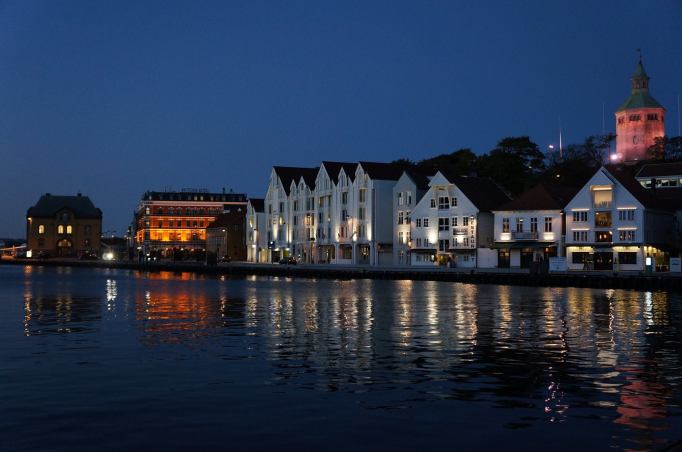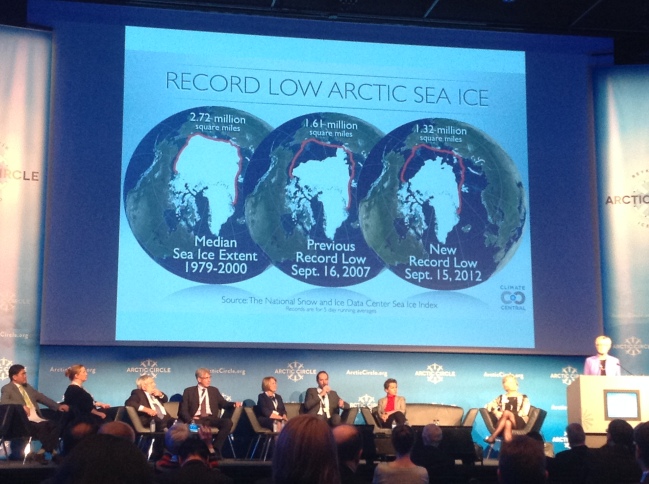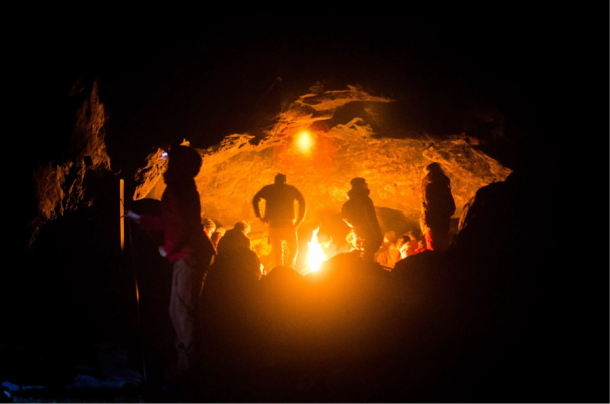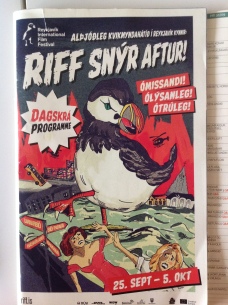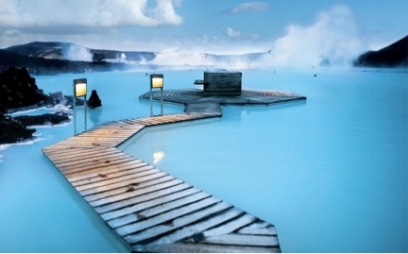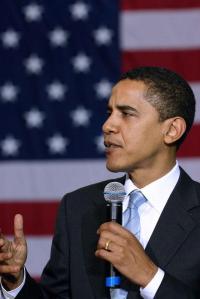Value and Sustainability: In Conferences, Caves and Music
The weather in Iceland is often stormy, the streets filled with wind and rain, the seas unsettled, and as we draw closer into winter everything is becoming darker and colder. But the skies here still produce indescribable moments of beauty, whether dancing with the lights of the Aurora Borealis or releasing the last rays of sunlight.
It has been such a busy couple of weeks in and around Reykjavik that I realize I have neglected the blog and am way overdue for an update. In October I participated in a series of excellent conferences, beginning with Finance at Work Workshop in Paris, where I presented a paper on ‘parallel economies’ the idea that environmental finance seeks creates a ‘parallel economy’ to the productive economy by using externality pricing to sync value back into natural resources. Following this I attended the Regional Innovation Policies Conference in Stavanger, Norway where I presented a co-authored paper on the competition of social value in the construction of multi-scalar governance. Stavanger is a stunning city and not really what one would expect of an ‘oil capital’. It is not that the petroleum interests are absent from the operation of the city; to the contrary there is a fascinating museum that explores the history, technology and challenges of offshore oil exploration. During the conference the municipal government hosted a wonderful reception in the building and tackled head on the tensions of sustaining Norway as an economic power and yet maintaining it as a socially conscious and environmentally aware state. The individuals I spoke with, including members of the municipal government, said that although there is a recognition that where the Norwegians have succeeded they have innovated (first learning to harness the marine environment an only in the 60s beginning to develop some of the most competent technologies for sea oil extraction), they have the luxury of not thinking too far into the future because their natural resources are so plentiful. The perspective is not surprising, and yet disappointing nonetheless. An alternative energy future is on the horizon, and yet the countries and companies with the greatest capacity to effect change are so consumed by producing wealth that they neglect to think ahead.
Nevertheless, Stavanger the city gives one the impression that the resources from the petroleum industry fuel economic development without overriding the cultural and intellectual heart of the city. The harbor, which leads into the gorgeous Lysefjord, is adorned with the footprints of Nobel Laureates from Al Gore to Shirin Ebadi.
Both conferences were helpful in solidifying my thinking about how value moves and is transformed through various forms of economic activity. I submitted the entry for the International Encyclopedia of Geography with a model of how value might move through various economic spheres linking consumption, commerce, finance and finally environmental finance through parallel processes of economic productivity and economic internalization of externalities. Still in the early phases of conceptualization, but I think I am on to something interesting here:
Toward the end of October, I attended the Trans Arctic Agenda meetings hosted by the Center of Arctic Policy Studies at the University of Iceland and the Arctic Circle Assembly, which convened politicians, champions of industry, academics, activists and representatives of indigenous tribes to discuss scientific findings, political aspirations, resource needs and the challenges of governing an opening Arctic Region. Both events were outstanding and showcased some of the core issues and discourses of sustainable development in the Arctic.
The events also helped me decide what I want to do with my next research project: map the values of sustainability across the Arctic Region. In the coming decades the Arctic will experience increasing pressure for development from various forces as the ice continues to melt, opening the possibility of oil and mineral extraction from the sea floor, the fishing of otherwise inaccessible fisheries, shipping and general geopolitical maneuvering. New governance mechanisms will be established to determine how these resources are utilized and by whom. The Arctic Circle has created an outstanding forum to focus the discussion and dialogue. It is clear that there are a variety of perceptions of what the Arctic is and how it might best be utilized. There is a need to understand how the variety of values from growth to environmental integrity to cultural preservation are dispersed across the region and across socio-demographic groups, so that that the mechanisms that are created can be held accountable to the values that exist. I came away from the meetings with a series of questions, a questionnaire to initiate my research, and an introduction to several individuals who are interested to purse the project with me, including fellow Fulbright Scholar Alyssa Grahame.
Aside from attending these conferences and initiating my research into sustainable values, I had several opportunities to further explore and enjoy the nature and art of Iceland. Christian Duell, an Australian friend, hosted his goodbye party around a campfire in a cave by the seaside. There he performed the music he had written during his short stay in Iceland; the sound and the setting were inspired.
In more formal settings, Iceland Airwaves, one of the premier festivals for showcasing up and coming artists from Iceland, and indeed the world, took place in Reykjavik from November 5th through the 9th. Thanks to the planning, guidance and connections of fellow Fulbright Scholar and Saga Fest organizer Scott Shigeoka, I was able to catch a few of the events, including the closing concert performed by the Flaming Lips. Above all, I appreciated their artistic flair.

Until next time, I wish you music, metallic beach balls, and confetti. Sjaumst.
I have been working on a revision for the International Encyclopedia of Geography. The editor noted that while I had covered the ‘new’ environmental finance, I had neglected the traditional relationship between the environment and finance capital and suggested that I review the debates between scholars like William Cronan and neo-Marxists over whether the source of value in economics is the natural environment or ‘dead labor’. In reviewing these debates I ended up trying to trace the development of historical materialism— the idea that social history is the history of the evolution of the social means of production—through Marx’s scholarship, partly for the review and partly for the book I am writing on markets. I found the work of Iván Szelényi, a sociologist who suggests that alienation is critical to the evolution of Marx’s thought. Most people know Marx as the political economist who wrote Capital, but few scholars of political economy (myself included) have read the works of the young Marx, the Hegelian social theorist. I started tracing the evolution of historical materialism through these early works.
In the German Ideology, Marx built directly on Adam Smith’s assumption that development is linear and singular. History is the story of the evolution of the means of production. After writing nearly a thousand pages on the theory he realized it was problematic because history is not linear; the Greek and Roman Empires of antiquity arguably were far more developed and with greater division of labor than the serfdoms of the middle ages that replaced them. The Grundrisse (also nearly a 1000 pages, and also abandoned until the early 20th century) reforms the theory, this time, suggesting that history is plural and multi-linear. Rather than being a history of the evolution of more complex divisions of labor, it is a story of how the forces of production revolutionize the relations of production. The theory comes full circle to alienation, even if in a way different from the Hegelian existentialism from which it began. Historical materialism is a history of alienation driven by increased privatization, first of everything that exists, and then arguably through various forms of modern finance, to the privatization of everything that does not yet exist.
In the three volumes of Capital, Marx then wrote a theory of the ‘laws’ of what he called ‘the generality of production’. Metabolism of natural resources is integral to theory and in some instances Marx directly addressed the decline of the natural environment with concepts like ‘the metabolic rift’—the idea that increasing the productivity of large-scale agriculture and industry ultimately leads to a decline of the long-term fertility and productivity of the soil. However, the relationship between the environment and the evolution of the forces and relations of production, as well as the implications of environmental decline, were never explicit in the theory. Indeed, as esteemed economic geographer David Harvey suggests, having addressed history Marx then abandoned history, and to some extent context. He sacrificed an analysis of what he envisioned as the ‘particularities’ of distribution and the ‘singularities’ of consumption (outside the realm of economics) to build a generalizable theory that could exist in any place and at any time.
I think there is something really important to be said about what historical materialism offers to the analysis of environmental governance, particularly to the issues of privatization and alienation, not just social, but also socio-natural. There is also something really important in the realms of political economy Marx didn’t study: distribution and consumption (use). As with classical and neo-classical economics, Marx ultimately produced a theory of exchange value, not a theory of use value. The governance of the natural environment necessitates an explicit analysis of the issues of use, and what alienation implies for use.
Elsewhere in Reykjavik another kind of RIFF has been raging across the city, the Reykjavik International Film Festival. This is a terrific annual event that brings a wide range of dramas and non-fiction film from over 40 countries. The festival highlights independent films and up-and-coming artists, with the goal of building inter-generational and international networks. It even has its own Manifesto that includes raising the creative capital of independent, local and international artists. I have had a chance to catch a couple of the films and have deeply enjoyed the thought-provoking and aesthetic works on display. And perhaps because I have spent a good chunk of time over the past few weeks reading Marx and other social theorists, it has brought me back to the question of why we love art. What does art give us? Almost universally, at every age in every culture, art—song, dance, music, film, etc—appeals to us. More fundamentally, why is it important that we love art? I think the answer brings us back to alienation and connection. Art connects us to the very essence of what it is to be human, enables us to experience the world and all of its emotions in an individual and social way. Art is not immune to the logic of profit, but it exists for something that preceded profit. It is meant to be appreciated and enjoyed with others, and in so doing it brings us connection and dialogue. So this week the young protestors in Hong Kong standing for democracy, the musicians of the Atlanta Symphony Orchestra ‘locked out’ of better labor conditions, and the film goers in Reykjavik escaping the monotony of working life might be worlds apart, but are closer than we think.
Sjáumst,
Janelle
Iceland, land of fire and ice
September 10, 2014
Greetings from Iceland!
I have now been in the country for two weeks and although I have spent quite a bit of that time settling in (finding a suitable apartment, getting my office set up, familiarizing myself with the city, and beginning to teach a course at the university) the country has already left a profound impression on me.
For those who have visited Iceland before it is a country of vast natural landscapes and resplendent beauty.
(source: http://designtaxi.com/news/358241/Stunning-Landscape-Photographs-Of-Iceland/)
Iceland is often aptly described as a land of fire and ice. The ice obviously comes from Iceland’s far northern geography. Because of its position atop the transatlantic ridge, Iceland is also an island of active volcanoes, many of which have intricate and meaningful names. For example, Eyjafjallajökull (island’s mountain glacier) made headline news in 2010 when its eruption cancelled all air traffic in and out of Europe for nearly one week, and as reporters struggled to pronounce its name (Eh-ya-fyatle-yo-kutl). The newest activity is coming from Bárðarbunga. Fortunately, the eruptions of Bárðarbunga have been through surface crevices spewing lava into Holuhraun, and as of yet have not caused air traffic disruptions. Nevertheless, the real threat would be if the eruptions melt part of its encasing Vatnajökull (glacier of lakes) causing massive flooding in the regions beneath. So yes, there is fire and ice here. It might even be an apt way to describe aspects of the culture, fiery and icy, sometimes all at once. Yet, for me, Iceland has become first and foremost a country of water.
(source: http://gudmann.photoshelter.com/image/I0000FTRVv.oyTYw)
Water is interwoven into the landscape and the lifestyle in multiple ways. First, there is the issue of the weather. Although there have been a couple of sunny dry days, the majority of the time so far has consisted of grey skies and rain. I was told not to bother with an umbrella (for one thing it signals to everyone around that you are a recently landed tourist) but for another it is completely useless because the sky doesn’t so much drop water as spit water in multiple directions with forceful wind. Water that falls vertically is ‘foreign rain’ and like umbrellas absent from the streets of Reykjavik.
On a brighter note, many cultural rituals revolve around Iceland’s access to geothermal water and miles of beautiful coastland. The national sport is sea swimming: swimmers strip down to their speedos and bikinis (not wetsuits) and brave the sea for a few frigid laps year round regardless of temperature. Fortunately these ventures are usually in close proximity to some form of a ‘hot pot’ or geothermal fed pool. Nauthólsvík Geothermal Beach is a local favorite hot spot.
The day I took the photo was one of Iceland’s rare sunny days, ‘a real summer treat.’ So despite the tepid 2 degree waters, swimmers were indulging all day rather than for a few hours. If sea swimming isn’t your cup of tea, there are plenty of other choices. In fact every neighborhood has its own swimming facility usually including an indoor or outdoor lap pool, a hot pool, even occasionally a good sauna or steam room. My favorite is Laugardalslaug.
A final advantage of the geothermal water is the clean energy and heat it provides. With the exception of transportation, Iceland is powered entirely from renewable energy. Sometimes geothermal energy and leisure even combine as in the case Iceland’s deluxe spa resort the Blue Lagoon, a beautiful hot spring spa nestled in a volcanic crater; its color derived from the mineral rich waters. The only catch—the water, and indeed their added minerals, are apparently supplied from the runoff of a neighboring power plant. The thought somehow still doesn’t deter from several indulgent hours of lounging, a silica facemask and a ‘detox smoothie.’
The fire, the ice, and all of the water make Iceland a terrific place for adventure. This weekend I am pursing a bit of adventure of my own. I plan to hike the Laugavegur trail with another Fulbright scholar and members of Iceland’s search and rescue team. These guys and gals are tough. They regularly save wayward tourists and sometimes even wayward Icelanders who become trapped by weather or poor decision-making while pursuing Iceland’s extreme sports. To train for these missions they routinely climb mountains, jump off glaciers, run across fields of molten lava (ok perhaps I exaggerate), but they are serious athletes! Already I am a bit nervous because the plan is a ‘3-day’ trek and all the online descriptions I can find suggest Laugavegur is a 4-5 day trek…rounding error? In any case I am going to ‘test the limits of the human spirit’ or at least the limits of my very human knees.
Until next time. Sjáumst! Janelle 🙂
The Experiences of a Fulbright Scholar in Iceland
Several years ago I created this blog to report my experiences attending the 2009 Climate Talks in Copenhagen. This semester I am studying energy policy and environmental finance at the University of Iceland as Fulbright Scholar, while teaching a course on sustainability. Georgia Tech very generously supported my Fulbright Fellowship. In exchange I thought it would be nice to once again share my experiences abroad with the Georgia Tech community. I will sometimes write about the subjects I am teaching, reading, and writing, but for the most part would like to use this blog to share my cultural experiences in Iceland. The Fulbright Program was established by Senator William Fulbright in the aftermath of the second world war with the belief that cultural education and exchange could build a lasting peace between nations. In that spirit, I would like to use this blog to serve as its own cultural exchange. I will do my best to post regularly and will look forward to your comments and feedback.
More soon…
Janelle
Losing our Biological History, and Perhaps Ourselves, in the Sixth Mass Extinction
Richard Leaky and Roger Lewin’s book The Sixth Extinction traces the history of life on the planet as we understand it in biology, paleontology and related disciplines, and tries to find a place and meaning for the human species. The fossil record demonstrates five mass extinctions in the history of life on the planet after the Cambrian explosion (in the last 500 million years), where up to 65% of extant species went extinct. Scientists estimate that we are in the midst of a sixth mass extinction and this one is man-made. Coming to terms with mass extinction and subsequent species renewal (granted within geological not human timeframes), one might conclude that the extinction we are experiencing does not matter. The history of life on Earth tells us that extinction like change is inevitable. Why the mass extinction we are driving matters can be found in a mixture of tangible and intangible values. Leaky and Lewin suggest three ways that we can value biodiversity: 1) the tangible benefits we can extract from our environment, such as food, raw materials, and medicines, 2) the less tangible benefits, the maintenance of the physical environment, in its circulation of gases, chemicals, and moisture, and 3) the intangible benefits, such as the aesthetic pleasure individual humans derive from their experience of the diversity of life around them.
The value of the first two is obvious, as is the fact that their loss is detrimental to our own existence. No one would reasonably argue for destroying the planet’s biota to the point where it no longer sustains human life. But as with climate change, there is considerable uncertainty about the exact impacts of species loss. We know there are consequences, but we do not fully understand them. How many species can we lose without significant change, and at what point will the Earth’s ecological and biological systems stop functioning altogether?
The third, intangible method of valuation needs more consideration as well. What does the loss of millions of species, most un-recorded, mean for understanding our history as well as our future? I would draw an analogy. After the U.S. invasion of Baghdad in 2003, little was done to stop the looting and pillaging of museums and other cultural sites (perhaps because it simply wasn’t possible). The world watched in horror as pieces of our human cultural heritage, in a place some would consider the cradle of civilization, were stolen or altogether destroyed. We feel a tremendous loss when something that is considered an irreplaceable part of our cultural heritage is destroyed and we make efforts to protect and preserve such heritage wherever we can. Should we not feel some similar attachment to the multiple components of our biological heritage? To the multiple species that are an integral part of how we have come to exist today and that shape existence on our planet. I guess the parallel question is if climate change is causing the extinction of millions of species, is there a place for intangible valuation within climate policy? Can we find a way to account for nature without an economic calculation? If the intrinsic value of our cultural heritage is any indication, our biological heritage deserves equal consideration. In destroying Earth’s species, we are collectively looting the world of treasures that we cannot replace.
The Georgia Tech Climate Policy Blog: A Religious Revival
Due to popular demand I have decided to revive the climate policy blog. I am going to take the opportunity to open with a somewhat taboo topic–religion. On Friday I attended an interesting talk hosted by Professor Judy Curry in Earth and Atmospheric Sciences. The presentation, given by Dr. David Gushee, Distinguished Professor of Christian Ethics, was titled ‘Understanding Conservative Religious Resistance to Climate Science.’
Dr. Gushee explained that one of the reasons Evangelicals have disregarded environmentalism is because the environmental movement took shape amongst the ‘sex, drugs and rock and roll’ of the 60s, and for better or worse environmentalism become associated with these characteristics. There are also concerns about the way the environmental movement has been interpreted in terms of population control and deism. Part of the problem may be that religion hasn’t ever really been welcomed into the climate change debate. Dr. Gushee pointed out that as scientists we are often not comfortable discussing religion. We like to convey climate change in levels of scientific certainty, leaving religion as a category outside of the debate. As policy makers or advocates we often engage various forms of economics and politics but not directly religion.
What we are facing in climate change or in the destruction of our global ecosystems more generally is not an exclusively political or scientific or economic issue, but a human issue. It is important to engage all aspects of that humanity. Turning a blind eye to aspects of life that make us professionally uncomfortable will not work, especially when they are aspects that are so fundamental to our societies.
Dr. Gushee’s presentation reminded me of an organization I came across while at a conference on Eastern European environmental governance in Oxford, the Alliance of Religions and Conservation (ARC). ARC is a secular organization that promotes conservation around the world by engaging local communities in the environmental messages that are found in their religious texts and traditions. Martin Palmer, ARCs Secretary General, stated the importance of working with the world’s religions as such, “Religious institutions have outlived every dynasty, every empire and they will outlive every ideology including the state. They will be there in a 1000 years’ time. When religions move, they move for generations not for a lifetime.”
To address climate change, we need the collaboration of most if not all of the world’s societies. We might more successfully get such collaboration by communicating to the heart of these societies. In the United States this requires in part finding a way to engage the religious right. As pointed out by Dr. Gushee, the Bible holds its own messages of conservation. Being heard is sometimes a matter of locating and delivering the right message. Can environmentalists and climate scientists engage with evangelical and other conservative religious communities to build common ground? The only way to find out is to do what Dr. Gushee does through his work and to start the conversation. Perhaps it is time for climate discourse to experience a religious revival.
Hopenhagen or Brokenhagen: Copenhagen Accord leaves some satisfied, many more disappointed
A deal was reached in Copenhagen between the major emerging economies and the United States (the BUICS)…It is being called the Copenhagen Accord. I think no one is quite certain what to make out of the result. Some have called it an absolute failure (particularly from the EU and G77 perspective). Some have called it an initial beginning step. I suppose is it is a mixture. President Obama swept in at the last minute cut a quick deal with China, Brazil, India and South Africa. The United States will try to make minimal reduction targets, and will work to leverage 100 billion a year by 2020 for developing countries mitigation and adaptation finance. In exchange the emerging economies will begin to account and report their emissions and try to achieve intensity reductions. It is good that these countries are joining the international regime, but many see it as just too little too late. The manner in which the accord was agreed completely subverted the negotiation process of the past two years. The accord, which most nations merely ‘took note of’ does not follow the format laid out in the Bali Action Plan, and does not address many of the important issues. Every other country was left to either accept it or to be dissatisfied, but that is neither a democratic nor a consensus based process. The BUICS might as well have had their own meeting in advance, made their agreement and come to the negotiating table to present their intentions. In the end that is what the COP amounted to. The accord does give some certainty to REDD, directly recognizing the importance of the program, and linking it to a planned $30 billion fund which should operate between 2010 and 2012. Considering that this was one of the few things most countries agreed on; it is a significant achievement. Hopefully the absence an international agreement (not just a BUICS agreement) will not leave the program struggling to find life. As President Obama concluded, ‘we still have to work for a legally binding agreement.’
In other words COP15 has pushed the real work into the indefinite future and wasted a golden opportunity to do something more substantive. All of the world’s leaders had come to the table and the whole world was watching. In the end this didn’t matter. In explaining the need to break from the Kyoto Protocol, avoid legal obligations and commit the developing world, President Obama explained in a press briefing that, ‘We [the US] were coming with a clean slate because we had been on the sidelines for many years. The Kyoto Protocol and other accords called on developed countries to engage in mitigation activities and to help developing countries with finance.’ The agreements left no responsibilities for developing countries. While there are very poor agrarian countries, there are also emerging industrializing countries like India and China. Leaving them out of an agreement was unacceptable to the United States and led to the fundamental split in perspective that deadlocked the negotiations. President Obama is correct that the agreement brokered by the BUICS cut the deadlock and achieved a compromise between these perspectives. But he is not correct that the United States was coming to Copenhagen with a clean slate. Our failure to engage for the past 12 years left us undoubtedly behind the rest of the developed world, but this doesn’t make our slate clean; it makes it inadequate. No great leader ever led standing behind and waiting on others to act.
It was a pleasure to follow this experience and to better understand how international political negotiations take place. Many of the delegates and even commentators to the blog called for action outside of international decision-making institutions. As demonstrated by this COP the construction of a climate regime at the international level is tedious and slow. Yet it is an important first step in that it sets the guidelines or the goals countries will try to achieve. No country (the United States included) can ignore climate change. Green growth has now become the only plausible model of development, and publics around the world are now paying attention. Despite the disappointment of the absences of an agreed legal or at least political commitment, the United States, China and India have finally dipped their toes into the water of the climate change regime. While it is not the same as diving in and swimming, these countries will eventually submerge completely (hopefully figuratively and not literally). In the meantime, it is up to all of us to do what we can from the grassroots. Change begins with one turned light switch, one recycled article, one un-purchased product, one living tree at a time. Thank you for allowing me to share this experience with you.
Cheers,
Janelle Knox-Hayes
COP refugee stranded in Paris: Talks make some progress
 I spent quite a bit of time in Copenhagen airport today, waiting for the snow to clear. There is a very interesting display by Vestas (a large solar wind producer) and Lego to demonstrate the power of natural energy. At the center of the display a 3 meter moving Lego windmill has been constructed. Around it are several rather neat displays that show the potential of wind power. Apparently, a single turbine repays its investment in 9 months. If you haven’t left Copenhagen yet, it is in terminal 2. The surrounding displays have moving Lego scenes of daily activity. There is a mountain factory, a state of the art house, a boat installing solar installations, a ski resort and a building topped by a hot water pool, all powered by the wind (in this case you have to blow into a device to start the electricity production). As you can see from the picture, European swimwear shares in the environmental ethic–less is more.
I spent quite a bit of time in Copenhagen airport today, waiting for the snow to clear. There is a very interesting display by Vestas (a large solar wind producer) and Lego to demonstrate the power of natural energy. At the center of the display a 3 meter moving Lego windmill has been constructed. Around it are several rather neat displays that show the potential of wind power. Apparently, a single turbine repays its investment in 9 months. If you haven’t left Copenhagen yet, it is in terminal 2. The surrounding displays have moving Lego scenes of daily activity. There is a mountain factory, a state of the art house, a boat installing solar installations, a ski resort and a building topped by a hot water pool, all powered by the wind (in this case you have to blow into a device to start the electricity production). As you can see from the picture, European swimwear shares in the environmental ethic–less is more.
 As for the COP, I missed the details in my travel travails, but Air France is good to its stranded passengers and I am in a rather nice hotel suite enjoying BBC news. It seems today saw some progress. The developed countries have committed to an 18% reduction target, but there is still discussion of whether or not developing countries will make targets of their own. The 2 degree temperature rise target has not yet been reduced, and a number of developing countries are demanding a $200 billion per year in funding. The US has offered to leverage $100 billion by 2020, but this depends on what the emissions cuts developing countries, particularly China agree to. Key US players including Secretary Clinton and Senator Kerry are lobbying for some action from the US. Chinese Vice Foreign Minister, He Yafei encouraged the move, saying the financial issue is important.” Secretary Clinton has prepared a major funding plan for developing countries, ‘It is no secret that we have lost precious time in these past few days. We can’t continue to let this be about us and them. The President is planning on coming tomorrow, obviously we hope there is something for him to come for.’ UK Prime Minister Gordon Brown offered his own sentiments, ‘In these few days in Copenhagen, which will be blessed or blamed for generations to come, we cannot let the politics of narrow self interests prevent our chance of survival,’ UN SecBan Ki-moon, remained optimistic ‘I believe we can seal a deal still in Copenhagen.’
As for the COP, I missed the details in my travel travails, but Air France is good to its stranded passengers and I am in a rather nice hotel suite enjoying BBC news. It seems today saw some progress. The developed countries have committed to an 18% reduction target, but there is still discussion of whether or not developing countries will make targets of their own. The 2 degree temperature rise target has not yet been reduced, and a number of developing countries are demanding a $200 billion per year in funding. The US has offered to leverage $100 billion by 2020, but this depends on what the emissions cuts developing countries, particularly China agree to. Key US players including Secretary Clinton and Senator Kerry are lobbying for some action from the US. Chinese Vice Foreign Minister, He Yafei encouraged the move, saying the financial issue is important.” Secretary Clinton has prepared a major funding plan for developing countries, ‘It is no secret that we have lost precious time in these past few days. We can’t continue to let this be about us and them. The President is planning on coming tomorrow, obviously we hope there is something for him to come for.’ UK Prime Minister Gordon Brown offered his own sentiments, ‘In these few days in Copenhagen, which will be blessed or blamed for generations to come, we cannot let the politics of narrow self interests prevent our chance of survival,’ UN SecBan Ki-moon, remained optimistic ‘I believe we can seal a deal still in Copenhagen.’
I hope there is more progress tomorrow, both for the COP and my own journey to Atlanta.
Cheers,
Janelle
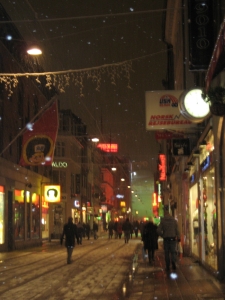 Sorry, this is a bit late, I have to catch my flight tomorrow and like the rest of Copenhagen I got caught in the snow tonight. Anyway I had a very eventful day outside of the COP.
Sorry, this is a bit late, I have to catch my flight tomorrow and like the rest of Copenhagen I got caught in the snow tonight. Anyway I had a very eventful day outside of the COP.
I finally got to the Copenhagen film festival and saw two fantastic films. I would like to screen both of these films and several others at Georgia Tech in the Spring. The first, called Hope in a Changing Climate, showed the power of restoring soil structure and natural vegetation. In China and Ethiopia degraded desert wastelands were converted to green oases in a matter of a mere fifteen years, by replanting trees, changing agriculture and grazing behavior. Vegetation is 90% water and prevents soil erosion, and organic soil stores 3 time more carbon than vegetation. If REDD succeeds, the restoration of millions of hectares of land could perhaps be tied in through an extension program Reducing Emissions from Degradation, Deforestation and Ecosystem Restoration (REDDER). Sounds long, but trust me it is the next big thing! 😉 After the film, director John D. Liu shared some profound conclusions, ‘We have to think beyond our localities, a restored ecosystem anywhere is a benefit to all of humanity. We need to have a species consciousness and act in the interest of everyone on the planet. This is the only way to prevent global catastrophe.’ The second, a film called Green by Patrick Rouxel, traced the destruction of forests in Indonesia for palm oil production. There is no dialogue in the film, only a mourning hymn in the background. Seeing the destruction of these forests and the species that depend on them puts in perspective what is at stake. Perhaps what is even sadder is the reminder that most of the industrialized world was once covered with forests. They are hundreds of years gone and our collective consciousness doesn’t even remember them.
My guest bloggers didn’t make it to the actual blog (this is hard work folks!), but I had dinner with two of them (Harro Van Assault, Vrije University Amsterdam and Kanako Morita, Tokyo Institute of Technology) and they shared some really good insights and news from the inside. Connie Hedregaard stepped down from her position as COP President. This is unusual and unfortunate for a number of reasons. One, it signals (as though everything else didn’t) that things are not going well and two, she is one of the few (if not the only) woman to ever make it to that position. A big message of this conference is that we need to involve the work of women, particularly in developing countries. One of the delegates even commented on Hedregaard’s Presidency, the great work that she was doing and the strong signal it sent to women all over the world. The official reason for her to step down was that someone more official (Danish Prime Minister Lars Lokke Rasmussen) was able and willing to lead the HLS, but this is not how other COPs have operated. There is also the fact that the Danish ministry lost credibility with the leaked Danish draft text, which particularly upset the G77. But I can’t help but wonder if she would have been so easily pushed aside if she were not a woman. I am not sure that Prime Minister Rasmussen is going to do anything different in her place and he doesn’t bring any continuity to the process. Meanwhile, outside, there was a NGO walk-out where badge members left the conference to protest the fact that numbers have become so restricted. A Dutch business leader decided to join the demonstration and was subsequently trapped outside without his coat. The protesters were not allowed back in…
During the plenary there were two speeches that caught everyone’s attention, one by Hugo Chavez, a 10 minute rant about the failure of capitalism (would really like to see this). The second a speech by Robert Mugabe, which underscored the importance of the environment. His new-found environmental ethic made most viewers uncomfortable, especially given his record on human rights and rule of law. May be able to get more details tomorrow. If not, I will sign off at the end of the conference with some analysis of the final result from Atlanta. Thank you to everyone for reading!
Cheers,
Janelle Knox-Hayes
Governor Schwarzenegger gets pumped up and calls for action from citizens everywhere at Hopenhagen
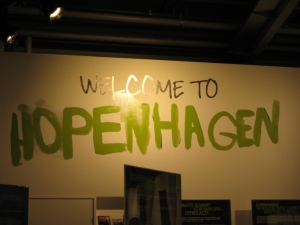 Goodmorning East Coast readers. I don’t have access to the COP conference site today, so I am wondering around the city at a number of different parallel events. I have also asked a few friends from other organizations who got passes to submit short ‘guest blog entries’ so may be able to post these later in the day. Aside from more protests, the big news on local Danish stations this morning while I was eating breakfast was that the Governator was at a local gymn getting pumped up for the Copenhagen Climate talks.
Goodmorning East Coast readers. I don’t have access to the COP conference site today, so I am wondering around the city at a number of different parallel events. I have also asked a few friends from other organizations who got passes to submit short ‘guest blog entries’ so may be able to post these later in the day. Aside from more protests, the big news on local Danish stations this morning while I was eating breakfast was that the Governator was at a local gymn getting pumped up for the Copenhagen Climate talks.
The City of Copenhagen is running a number of events in the city square under the 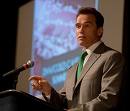 rubric of ‘Hopenhagen’. At the City hall this morning Governor Schwarzenegger spoke at a meeting of mayors, with mayors from around the world, and said ‘It is wrong to think the solutions have to come from the federal government. No great movement was ever top down; it happened at the grassroots level. We need action from everyday citizens.’ Along with some of the mayors present, he highlighted the great work happening in States like California and in major cities like Hong Kong. When it comes down to it, addressing climate change is up to all of us. The actions of individuals to minimize the energy we use, the waste we create and the resources we consume will make a difference.
rubric of ‘Hopenhagen’. At the City hall this morning Governor Schwarzenegger spoke at a meeting of mayors, with mayors from around the world, and said ‘It is wrong to think the solutions have to come from the federal government. No great movement was ever top down; it happened at the grassroots level. We need action from everyday citizens.’ Along with some of the mayors present, he highlighted the great work happening in States like California and in major cities like Hong Kong. When it comes down to it, addressing climate change is up to all of us. The actions of individuals to minimize the energy we use, the waste we create and the resources we consume will make a difference.

